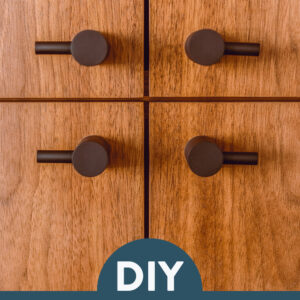Wood cabinets can add a touch of warmth and sophistication to any kitchen or bathroom. To ensure their longevity and keep them looking their best, regular cleaning and maintenance are essential. In this step-by-step guide, we will walk you through the process of cleaning wood cabinets effectively, using safe and natural methods.
Whether you have recently installed modern wood cabinetry, older wood cabinets you wish to restore to their former glory, or wood cabinets that require preparation before painting, we have got you covered!
Cleaning Wood Cabinets Before you Paint Them

Before embarking on a project to paint your wood cabinets, it’s crucial to thoroughly clean them to ensure a smooth and long-lasting finish. Proper cleaning removes dirt, grease, and other contaminants that can hinder paint adhesion. You can use this guide to effectively clean your wood cabinets before painting, ensuring optimal results for your painting project.
Allow the cabinets to dry completely before proceeding with the painting process. This step is crucial to ensure the paint adheres properly and prevents any moisture from getting trapped beneath the paint layer.
FAQs About Cleaning Wood Cabinets
It is generally not recommended to use regular household cleaners on wood cabinets, as they can contain harsh chemicals that can damage the wood finish. It’s best to use mild dish soap, a wood cleaner specifically formulated for cabinets, or natural cleaning solutions like vinegar and water.
The frequency of cleaning will depend on various factors such as usage, cooking habits, and the environment. As a general guideline, it is recommended to clean wood cabinets every few months or as needed. However, high-traffic areas or cabinets near the stove may require more frequent cleaning.
It is not recommended to use abrasive scrub brushes or steel wool on wood cabinets, as they can scratch or damage the wood surface. Instead, try using a soft-bristle brush or a gentle scrubbing pad specifically designed for delicate surfaces.
Grease buildup can be challenging to remove from wood cabinets. One effective method is to make a paste using baking soda and water. Apply the paste to the greasy areas and let it sit for a few minutes before gently scrubbing with a soft cloth. Rinse thoroughly and dry the cabinets afterward.
Furniture polish is not recommended for routine cleaning of wood cabinets. While it may temporarily enhance the shine, it can leave a residue that interferes with paint or stain adhesion.
If you want to add shine to your cabinets, consider using a small amount of olive oil or a dedicated wood polish made specifically for cabinets.
The cleaning process for the insides of the cabinets is similar to the exterior. Use a mild dish soap or a wood cleaner diluted in warm water to wipe down the shelves and interior surfaces.
Pay attention to any spills or stains and make sure to dry the interior thoroughly to prevent moisture-related issues.
Yes, vinegar and water can be used as a natural cleaning solution for wood cabinets. Mix equal parts of white vinegar and water in a spray bottle, then spray the solution onto a cloth or sponge. Gently wipe down the cabinets, rinse with clean water, and dry them thoroughly.
How to Clean and Maintain Wood Cabinets

To ensure their longevity and keep them looking their best, wood cabinets require regular cleaning and maintenance. In this step-by-step guide, we will walk you through the process of cleaning wood cabinets effectively, using safe and natural methods. Let's get started!
Photo by Tina Witherspoon on Unsplash
Materials
- Microfiber cloths or soft, lint-free rags
- Mild dish soap or a wood cabinet cleaner
- White vinegar
- Olive oil or a commercial wood polish (optional)
Tools
- Soft-bristle brush or old toothbrush
- Bucket or bowl
Instructions
- Gather Your Supplies
Before you begin cleaning your wood cabinets, gather the following supplies:
- Microfiber cloths or soft, lint-free rags
- Mild dish soap or a wood cabinet cleaner
- Warm water
- White vinegar
- Olive oil or a commercial wood polish (optional)
- Soft-bristle brush or toothbrush
- Bucket or bowl - Remove Dust and Debris
Using a microfiber cloth or soft rag, gently wipe down the cabinet surfaces to remove any loose dust, debris, or food particles. Pay attention to corners, nooks, crannies, crevices, and handles. This step will prevent scratching the wood during the cleaning process - Prepare a Cleaning Solution
In a bucket or bowl, mix a solution of warm water and a small amount of mild dish soap or a wood cabinet cleaner. Avoid using harsh chemicals or abrasive cleaners, as they can damage the wood finish. Alternatively, you can create a natural cleaning solution by combining equal parts of white vinegar and water. - Clean the Cabinets
Dip a microfiber cloth or soft rag into the cleaning solution and wring out any excess liquid. Gently wipe down the cabinet surfaces, working in small sections at a time. Use circular motions to remove dirt, grease, and stains. For stubborn grime, use a soft-bristle brush or toothbrush to gently scrub the affected areas. Remember to clean both the interior and exterior of the cabinets. - Rinse and Dry
After cleaning, dampen a clean cloth with plain water and wipe down the cabinets to remove any residue from the cleaning solution. Ensure all soap or vinegar is rinsed off thoroughly. Then, use a dry microfiber cloth or soft rag to dry the cabinets completely. Moisture left on wood surfaces can cause warping or damage over time. - Polish and Protect (Optional)
To restore shine and provide extra protection, you can apply a thin layer of olive oil or a commercial wood polish to the cabinets. Use a clean cloth and apply the polish in the direction of the wood grain. Buff gently to bring out the natural luster of the wood. - Regular Maintenance
To keep your wood cabinets looking their best, it's important to maintain them regularly. Wipe up spills and stains promptly, and avoid using abrasive sponges or harsh chemicals. Additionally, consider applying a protective wax or varnish every few years to preserve the wood's beauty and extend its lifespan.
By following these simple steps, you can effectively clean and maintain your wood cabinets, ensuring their longevity and keeping them looking beautiful for years to come. Remember to use gentle cleaning solutions, avoid abrasive materials, and perform regular maintenance to protect and preserve your investment in stunning wood cabinetry.




